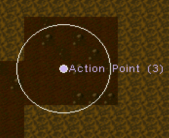Action Points are invisible points (that is, the Action Point itself is invisible, not the area designated as one) on maps, used as event triggers and/or entry points for creatures and parties.
Dungeon Keeper[]

An Action Point being shown in the Dungeon Keeper Editor
An Action Point is defined as a circle with a centre placed on a subtile and a radius also measured in subtiles. When a creature enters the circle, the Action Point is triggered, subject to certain conditions.
In the original game, Action Points can only be triggered by human players, and, according to the editor manual, are player-independent, meaning that there is only one, game-wide record of whether an Action Point has been triggered. However, mapmakers can script different events according to which player triggered it. Action Points cannot be triggered again unless reset with the RESET_ACTION_POINT command.
In KeeperFX, Action Points can be triggered by computer players (including the hero player) too, and are player-dependent, meaning that there is a record for each player of whether it has been triggered by that player. This means that a player can trigger an Action Point even if it has already been triggered by another player, and events can be scripted without having to reset the Action Point should it be triggered by a player other than the intended initiator of said event. However, there is no way to reset an Action Point only for certain players: when it's reset, it's reset for all players.
Each Action Point is assigned a number, used in the level's script. What happens when an Action Point is triggered depends on the script. A common event is a party of heroes spawning upon entering a room or area with the Action Point. The only way to tell when you've triggered an Action Point is through scripted events.
When used as entry points, creatures and parties spawning for the heroes appear to come down from the ceiling, along with a (harmless) cave-in. Tunnellers (even hero Tunnellers) and creatures belonging to a Keeper simply materialise there out of thin air. Action Points can always be used as entry points, regardless of whether it's been triggered or not.
Hero Gates are treated as Action Points. When used as such, its number turns negative; e.g. Hero Gate 1 is Action Point -1, Hero Gate 2 is Action Point -2, and so on. Hero Gates can only be used as Action Points as entry points, not as trigger points. Creatures entering through a Hero Gate do so in a manner similar to how an Imp is summoned when using Create Imp.
Action Points' coördinates are stored in the level's .apt file. Unlike slabs (.slb file), the grid is 255x255 tiles, not 85x85, as each tile is a 3x3 grid of subtiles).
A map can have up to 32 Action Points, though this limit has been increased to 256 in newer versions of KeeperFX.
Dungeon Keeper 2[]

An Action Point in Warcry
Action Points also exist in Dungeon Keeper 2, but are instead square and are defined through the script, instead of being placed on the map. In addition, more specific checks are possible, including the owner of a triggering creature and checking if a player builds in it. They can also function as waypoints for heroes and parties; they can be set to sequentially navigate to Action Points.[1]
Like the first Dungeon Keeper, they can be used as entry points for creatures and parties, but for heroes, using Hero Gates is much more common.
References[]
- ↑ Dungeon Keeper 2 Editor manual. section 7.3.
| ||||||||